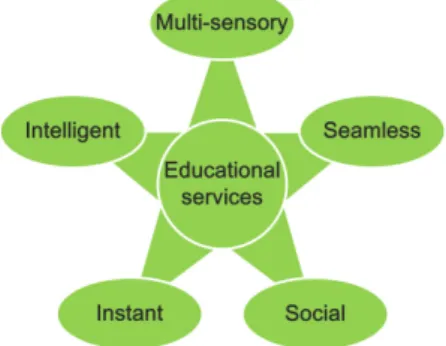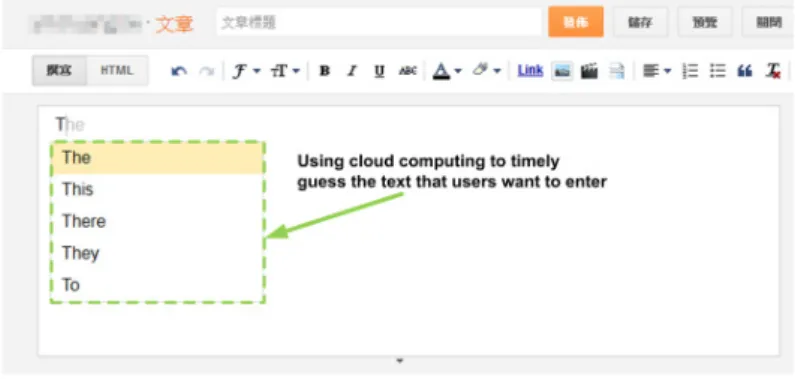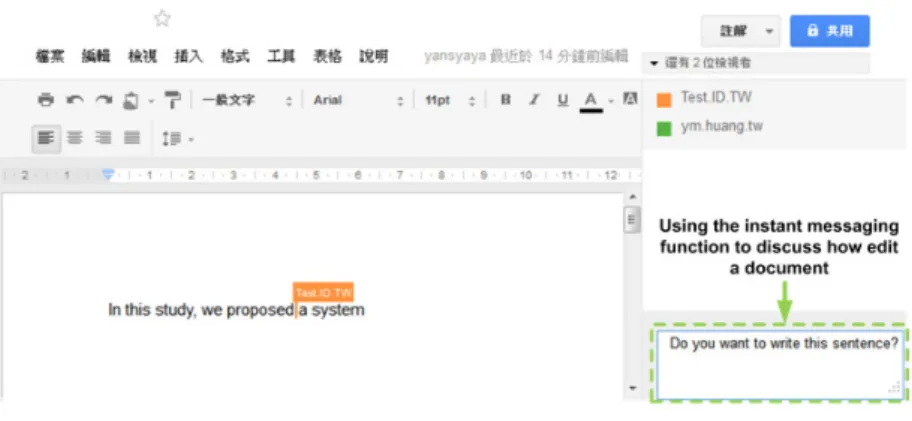James J. (Jong Hyuk) Park et al. (eds.), Human Centric Technology and Service in Smart Space, LNEE 182, pp. 311–316, DOI: 10.1007/978-94-007-5085-2_41,
© Springer Science+Business Media Dordrecht 2012
Framework
Chia-Sui Wang1, Yong-Ming Huang2, and Yueh-Min Huang2,3,* 1 Department of General Education, Chia Nan University of Pharmacy & Science, Taiwan 2
Department of Information Technology, Chia Nan University of Pharmacy & Science, Taiwan
3
Department of Engineering Science, National Cheng Kung University, Taiwan didijayjay@gmail.com, ym.huang.tw@gmail.com,
huang@mail.ncku.edu.tw
Abstract. Cloud computing has been regarded as the most potential technology to
realize innovative educational services, because it intrinsically provides massive computing and storage capacities. Accordingly, many researchers have noticed that the potential of cloud computing in driving the educational innovative applications. Despite much research on cloud to education, little effort has been devoted to explore the impacts of cloud computing on educational services. To this end, we intend to unveil those potential impacts and see to how the educational services can be benefited by cloud. Overall, we conclude that with the assistance of cloud computing, the educational services can be identified by five intrinsic major characteristics: instant, intelligent, multi-sensory, seamless and social.
Keywords: Cloud computing, Education.
1 Introduction
Cloud computing has been regarded as the most potential technology to realize differ-ent kinds of innovative application. It is a computing mode of networks in providing software and hardware resources, placed in a data center, to provide services [2]. If the cloud is accessible to the public, it is called public cloud, while it is private one if for an internal organization [2]. By taking advantages of dynamic massive storage and massive calculation [7], users can flexibly enjoy the convenience of cloud computing.
Of late, many researchers have noticed that the potential of cloud computing in driv-ing the educational innovative applications. They have unfolded some of its applications to education. Sultan argued that the cash-strapped educational institutions can use it to deliver a variety of information technology services due to its pay-as-you-go mode [14]. They indicated that in the educational institutions of some areas, such as Middle East and North Africa, cloud computing is viewed as an empowering tool used to advance the development of the educational technology, since cloud computing can save much time to build and maintain their own information technology infrastructure. Similarly, Wheeler and Waggener also indicated that cloud computing provides much richer
services over the Internet than before, useful for delivering the information technology services of educational institutions [17]. For example, Google Apps for Education and Google Docs services are tailored to fit the needs of educational institutions. Those services may provide a platform for those institutions to develop their own ones, facili-tating teaching and learning purposes. For example, Al-Zoube applied Google Docs service to develop a cloud-based learning system and indicated that many applications such as word processing, spreadsheets, or presentations can be used through web browsers due to cloud computing [1]. Such web-based applications can provide students and teachers with free or low-cost schemes to supersede expensive proprietary produc-tivity tools. More importantly, such web-based applications are innately useful for achieving collaborative learning activities such as collaborative writing [13]. Later, Calvo et al. also applied Google Docs service to develop a cloud-based learning tool to support the collaborative writing, capable of managing collaborative and individual writing assignments in large cohorts [3]. Moreover, Calvo et al. conducted an empirical analysis in order to realize the perspectives of lecturers and students on the tool. Their results revealed that the lecturers considered the tool quite time-saving for distributing assignments, but students took confusing view of it. On the other hand, some education-al applications are found by using the private cloud. Dong et education-al. proposed a framework of private cloud to embrace the benefits of cloud computing [6]. It literally improves the performance, availability and scalability of traditional learning systems and further of-fers better services for educational purposes. Afterward, Ouf et al. extended the work of Dong et al. to integrate Web 2.0 technologies into a cloud-based learning system for promoting the social interaction among students [11]. Later, Doelitzscher et al. pre-sented a systematic study about how to use private cloud to develop a cloud-based edu-cational system, which involves information technology infrastructure, software opment platform, and educational software applications [5]. Recently, Vaquero devel-oped a private cloud called EduCloud to support an advanced computer science course and conducted an empirical analysis to explore whether cloud computing is useful in educational scenarios for computer science students [5]. His results revealed that cloud computing did not help motivate students in terms of performance, but it comes with the advantage of avoiding much effort of setting up the software necessary for course activities.
Despite much research on cloud to education, little effort has been devoted to ex-plore the impacts of cloud computing on educational services. To this end, we intend to unveil those potential impacts and see to how e-learning can be benefited by cloud.
2 Characteristics of Cloud Computing
Cloud computing intrinsically provides massive computing and storage capacities, enabling the delivery of a variety of service [14]. By its intrinsic features, although some researchers have interpreted it in different perspectives [7, 15], most of them state four basic characteristics of it: 1) it is applicable to massive storage and massive calculation; 2) its payment mode is pay-as-you-go, the users only need to pay for actually used resources; 3) it is a computing mode providing services according to requirements, the required resources may not be allocated beforehand; 4) it is a ser-vice-oriented architecture, the service scale can be set and provided dynamically
according to requirements [7, 15]. Fundamentally, cloud computing provides three levels of service: infrastructure as a service (IaaS), platform as a service (PaaS), and software as a service (SaaS), as summarized in the following.
IaaS offers hardware infrastructure such as computing power and storage space as services. It enables users to directly rent the hardware infrastructure rather than spend-ing time and budget to build their own [4, 7, 15], with the advantage of the infrastruc-ture being scaled easily to accommodate the fuinfrastruc-ture demand [4, 16]. Two well-known examples in this service are Amazon EC2 (Elastic Cloud Computing) for supplying computing power service and Amazon S3 (Simple Storage Service) for supplying storage space service.
PaaS offers software development platform as services. This service enables users to directly design, implement, debug, test, deploy and operate their software in cloud [16]. Unlike IaaS, the users of PaaS do not need to address hardware configurations or software installations, instead, they can utilize PaaS to directly create their own soft-ware in cloud. Two well-known examples in this service are Google App Engine and Microsoft Azure that allow users to develop software in cloud without dealing with hardware and software configurations.
SaaS mainly offers software on the Internet as services. This service enables users to directly access software by using the Internet instead of installing special software on their computer [15]. Unlike PaaS, SaaS only hosts completed software whereas PaaS offers a development platform that hosts both completed and in-progress soft-ware [4]. Examples of Google Apps for Education and Google Docs belong to this category, which provide we-based educational and office software applications.
3 Impact of Cloud Computing on Educational Services
Defined as various software applications for education, educational services can be application programs of open source, proprietary or others. Distinguished from tradi-tional e-learning environment, in cloud computing contexts, the educatradi-tional services intend to provide learners various services with five major characteristics: instant,
intelligent, multi-sensory, seamless and social, as shown in Fig. 1.
Instant: it refers to instant services, such as Google Instant [8] and Google Scribe
[9]. Google Instant provides an instant searching engine, while Google Scribe pro-vides a just-in-time aid for writing, as shown in Fig. 2. The common characteristic of them is to use cloud computing to anticipate the text being entered every moment, so as to provide the search result or suggested words to reduce the user's input burden and even facilitate alternative options. Accordingly, it can be foreseen that cloud computing is useful to realize instant services so as to promote the learning efficiency.
Fig. 2. The Google Scribe
Intelligent: it refers to intelligent services. For example, Google Goggles [10] is an
intelligent image searching engine, running in mobile devices to search the photos taken by users. Up to now, it can identify letters, landmarks, books and signs automat-ically. Specifically, Google Goggles employs artificial intelligence (AI) technology for image recognition, realized by cloud computing to instantly respond the request. Consequently, it can be foreseen that cloud computing is able to fast execute complex AI applications to provide intelligent services.
Multi-sensory: it refers to the service that provides users with multi-sensory
expe-rience, such as Qwiki [12]. Qwiki is a search engine that provides narrated slideshows instead of links to give users a multi-sensory experience. Specifically, Qwiki automat-ically collects associated texts, images, videos, and voices on a subject from cloud and then reorganizes them as a sort of narrated slide show. As a result, users can easi-ly obtain a short and interactive story about the subject from Qwiki. In a sense, cloud computing enables services into multi-sensory experience so as to help learners ac-quire information in multiple angles.
Seamless: it refers to seamless use of service, such as Google Docs. Google Docs is a
word processing service, in which users can directly create and edit documents, spreadsheets or presentations on cloud, so that users can seamlessly access their files. Based on the paradigm, users can have services anywhere through different kind of terminal, such as the browsers of general computers or the apps of mobile devices [18]. Consequently, those services are accessible ubiquitously regardless of end devices.
Social: it refers to the service for social interaction, such as Facebook and Google
Docs. Facebook is the most famous social networking site at present, providing users with many functions for social interaction, such as message boards, chat rooms, blog-ging and games. Thus, users can use Facebook to find their friends, and even know their friends’ friends, so as to expand their circles. Even more, Google Docs not only provides users with a word processing service, but also facilitates them with social interaction, such as collaborative editing. During collaborative editing, users and peers can use instant messaging to discuss how to edit a document concurrently, as shown in Fig. 3. Accordingly, cloud computing enables services possess more social interaction elements, bringing learners together.
Fig. 3. The Google Docs
4 Conclusions
Cloud computing has a considerable potential for realizing different kinds of innova-tive application. This paper describes how we explored the impacts of cloud compu-ting on educational services. Overall, with the assistance of cloud compucompu-ting, the services of e-learning can be identified by five intrinsic major characteristics: instant,
intelligent, multi-sensory, seamless and social. As the major characteristics are
in-volved in educational services, the learners’ learning will become more autonomous, convenient and meaningful.
Acknowledgements. The authors would like to thank the National Science Council of the Republic of China for financially supporting this research under Contract No. NSC 100-2511-S-006-014-MY3, NSC 100-2511-S-006-015-MY3, NSC 100-2631-S-006 -002, and NSC 100-2631-S-011-003.
References
1. Al-Zoube, M.: E-learning on the cloud. International Arab Journal of e-Technology 1(2), 58–64 (2009)
2. Armbrust, M., Fox, A., Griffith, R., Joseph, A.D., Katz, R., Konwinski, A., Lee, G., Patter-son, D., Rabkin, A., Stoica, I., Zaharia, M.: A view of cloud computing. Communications of the ACM 53(4), 50–58 (2010)
3. Calvo, R.A., O’Rourke, S.T., Jones, J., Yacef, K., Reimann, P.: Collaborative writing sup-port tools on the cloud. IEEE Transactions on Learning Technologies 4(1), 88–97 (2011) 4. Dillon, T., Wu, C., Chang, E.: Cloud computing: issues and challenges.In. In: Proceedings
of the 24th IEEE International Conference on Advanced Information Networking and Ap-plications, Perth, Australia (2010)
5. Doelitzscher, F., Sulistio, A., Reich, C., Kuijs, H., Wolf, D.: Private cloud for collabora-tion and e-learning services: from IaaS to SaaS. Computing 91(1), 23–42 (2011)
6. Dong, B., Zheng, Q., Qiao, M., Shu, J., Yang, J.: BlueSky Cloud Framework: An E-Learning Framework Embracing Cloud Computing. In: Jaatun, M.G., Zhao, G., Rong, C. (eds.) CloudCom 2009. LNCS, vol. 5931, pp. 577–582. Springer, Heidelberg (2009) 7. Foster, I., Zhao, Y., Raicu, I., Lu, S.: Cloud computing and grid computing 360-degree
compared. In: Proceedings of the Grid Computing Environments Workshop, Austin, Tex-as, USA (2008)
8. Google. Google Instant (2012a),
http://www.google.com/insidesearch/instant-about.html 9. Google. Google Scribe (2012b), http://scribe.googlelabs.com/
10. Google. Google Goggles (2012c), http://www.google.com/mobile/goggles/ 11. Ouf, S., Nasr, M., Helmy, Y.: An enhanced e-learning ecosystem based on an integration
between cloud computing and Web2.0. In: Proceedings of the 10th IEEE International Symposium on Signal Processing and Information Technology, Luxor, Egypt (2010) 12. Qwiki (2012), http://www.qwiki.com/
13. Siegle, D.: Cloud computing: a free technology option to promote collaborative learning. Gifted Child Today 33(4), 41–45 (2010)
14. Sultan, N.: Cloud computing for education: a new dawn? International Journal of Informa-tion Management 30(2), 109–116 (2010)
15. Vaquero, L.M.: Educloud: Paas versus Iaas cloud usage for an advanced computer science course. IEEE Transactions on Education (in press), doi:10.1109/TE.2010.2100097 16. Weber, A.S.: Cloud computing in education in the Middle East and North Africa (Mena)
region: can barriers be overcome? In: Proceedings of the 7th International Scientific Con-ference eLSE - eLearning and Software for Education, Bucuresti, Romania (2011) 17. Wheeler, B., Waggener, S.: Above-campus services: shaping the promise of cloud
compu-ting for higher education. Educause Review 44(6), 52–67 (2009)
18. Zhang, S., Zhang, S., Chen, X., Huo, X.: Cloud computing research and development trend. In: Proceedings of the 2nd International Conference on Future Networks, Hainan, China (2010)


